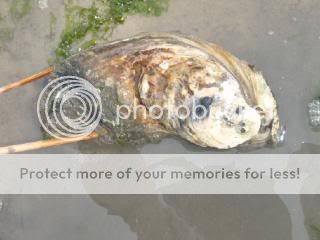OH YES!! one important thing, as you might notice, some of the animals are picked up by the guide to take photos. UNLESS YOU'RE SURE THAT the animals are not dangerous or toxic and YOU KNOW HOW TO HANDLE THEM WITH CARE, then it would be fine to pick them up. IF NOT, please take nothing but photos, leave nothing but footprints!!!!!
As Chek Jawa consists of 6 different ecosystems, the types of fauna and flora various greatly. Other than the really common ones, I always get to see new stuff even going back to the same place!!!
Barnacles. The ones with the longest penis...
Seastar. This seastar has been given a nickname "Ferrari" seastar cos it moves at great speed burying itself into the sand.
Knobbly Seastar.
Button Snail's shell with hermit crab.
Ball Moon Snail (Polinices didyma).
This one got its muscles all out!!!
Developing eggs of Drill Snail. If you have read my previous entries, you would know that the colour of the eggs of the drill snails are yellow, these are slightly purplish. According to Alan, these are in the developing stage. Yellow ones are fresh eggs.
Sand Bubbler Crab??
Sea cucumber.
Ball Sea cucumber.
Thorny sea cucumber.
Sea cucumber in its nature habitat. Most of its body would be buried but some part would be exposed. So, many people would think that it's a really small animal, but when they dig up the sea cucumber they are usually shocked by their size.
Sea hare.
Jellyfish
HUGE OYSTER!!!
Scorpionfish or Toadfish?? Really cool to see these animals. I usually differentiate them from the scorpionfish by the eyes. For scorpionfish, the eyes are usually protruding while it is not so for toadfish.. But this is not a sure way to identify them... You've got to ask the experts...
Fireworm (Chloeia flava). This one doesnt look like the usual fireworm I assumed. But according to Adelle, it is...
Moult of flower swimming crab. Really perfect remains of the crab!!! I learnt that the males get to change their penis everytime they moult too!!! HAHA.
Noble Volute. Oh!!! This cool creature is absolute stunning. Though I do think that they're numbers are rather limited, but i'm relieved to see at least 1 or 2 during every guided walks.
Unknown nudibranch?? We saw at least 2 of these on 28 May... Let me know if you could identify this weird animal!!!
Mudskipper. These animals can stay above water for a really long time. You'll find them in the mangrove habitat.
Evidence of monkey eating durian!!!! Even though the durians have not ripen yet, the monkeys had too a step ahead to harvest them... It feels like monkey also waste food!!! HAHA... I think it's going to be fruiting season.
Fiddler Crab. What's a trip to Chek Jawa without seeing these crabs!!! They are EVERYWHERE!!! They can come in different colours too!! I also learnt that like human, they can be right-handed or left-handed!!! :) The males have one larger claw to attract females and fight off other males... but other than that, that larger claw is of no other use.
Huge Female spider.
Oriental whip snake (Ahaetulla prasina). This snake is such a pretty one!! Its lime green body is so bright but at the same time, allows it to camouflage perfectly on the trees!!! They are mildly venomous and docile animals that can grow up to 2m long... I wish I could take a photo of its eyes!! Maybe next time!! :)
Cotton stainer bug (Dysdercus decussatus). These bugs feed on sea hibiscus (hibiscus tiliaceus). According to Adelle, these bug are irritants to farmer and having red ants could eliminate them from the hibiscus plant. You'll usually find them clustering on the underside of the leaves. At first sight from far, many people would find them really disgusting but a close look at them usually change their mind. They have a really pretty red and black pattern on them. The young one which cant fly (adults can) has a pattern that looks like a smiley face.
Here is a mating pair!!! :)
Of course, coming to Ubin increases your chances to sight the magnificent hornbills. 3 species of hornbills are recorded in Singapore but nowsadays, we only see 2 species. on 27 May, Alan, Christophe, KC and I had a great opportunity to snap photos of a pair of hornbill side-by-side. According to Alan, it is extremely rare to see the mom and dad hornbill to be next to each other!!! HOW LUCKY!! the following day, I saw another pair of hornbills. Might be the same pair but this time they werent together...
27 May
28 May
Seashore nutmeg. Food for the hornbills.






































No comments:
Post a Comment